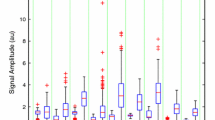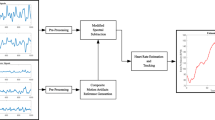Abstract
Photoplethysmogram (PPG) signals are widely used for wearable electronic devices nowadays. The PPG signal is extremely sensitive to the motion artifacts (MAs) caused by the subject’s movement. The detection and removal of such MAs remains a difficult problem. Due to the complicated MA signal waveforms, none of the existing techniques can lead to satisfactory results. In this paper, a new framework to identify and tailor the abrupt MAs in PPG is proposed, which consists of feature extraction, change-point detection, and MA removal. In order to achieve the optimal performance, a data-dependent frame-size determination mechanism is employed. Experiments for the heart-beat-rate-measurement application have been conducted to demonstrate the effectiveness of our proposed method, by a correct detection rate of MAs at 98% and the average heart-beat-rate tracking accuracy above 97%. On the other hand, this new framework maintains the original signal temporal structure unlike the spectrum-based approach, and it can be further applied for the calculation of blood oxygen level (SpO2).




Similar content being viewed by others
Reference
Allen J. Ph al measurement. Physiol Meas. 2007;28(3):R1–39.
Petersen C, Gan H, MacInnis M, Dumont G, Ansermino J. Ultra-low-cost clinical pulse oximetry. In: Conference proceedings: annual international conference of the IEEE Engineering in Medicine and Biology Society. 2013. Pp. 2874–2877.
Kim B, Yoo S. Motion artifact reduction in photoplethysmography using independent component analysis. IEEE Trans Bio-Med Eng [serial online]. 2006;53(3):566–8.
Krishnan R, Natarajan B, Warren S. Two-stage approach for detection and reduction of motion artifacts in photoplethysmographic data. IEEE Trans Bio-Med Eng. 2010;57(8):1867–76.
Yao J, Warren S. A short study to assess the potential of independent component analysis for motion artifact separation in wearable pulse oximeter signals. Conf Proc Annu Int Conf IEEE Eng Med Biol Soc. 2005;4:3585–8.
Ram MR, Madhav KV, Krishna EH, Komalla NR, Reddy KA. A novel approach for motion artifact reduction in PPG signals based on AS-LMS adaptive filter. IEEE Trans Instrum Meas. 2012;61(5):1445–57.
Yousefi R, Nourani M, Ostadabbas S, Panahi I. A motion-tolerant adaptive algorithm for wearable photoplethysmographic biosensors. IEEE J Biom Health Inform. 2014;18(2):670–81.
Murthy N, Madhusudana P, Suresha P, Periyasamy V, Ghosh P. Multiple spectral peak tracking for heart rate monitoring from photoplethysmography signal during intensive physical exercise. IEEE Signal Process Lett. 2015;22(12):2391–5.
Mashhadi MB, Asadi E, Eskandari M, Kiani S, Marvasti F. Heart rate tracking using wrist-type photoplethysmographic (PPG) signals during physical exercise with simultaneous accelerometry. IEEE Signal Process Lett. 2016;23(2):227–231.
Zhang Z. Photoplethysmography-based heart rate monitoring in physical activities via joint sparse spectrum reconstruction. IEEE Trans Bio-Med Eng. 2015;62(8):1902–10.
Zhang Z, Pi Z, Liu B. TROIKA: a general framework for heart rate monitoring using wrist-type photoplethysmographic signals during intensive physical exercise. IEEE Trans Bio-Med Eng. 2015;62(2):522–31.
Wu H-C, Gupta N, Mylavarapu P. Blind multiridge detection for automatic nondestructive testing using ultrasonic signals. IEEE Trans Ultrason Ferroelectr Freq Control. 2006;53(10):1902–11.
Mood A, Graybill F, Boes D. Introduction to the theory of statistics. 3rd ed. Boston: McGraw-Hill; 1974.
Author information
Authors and Affiliations
Corresponding author
Rights and permissions
About this article
Cite this article
Pu, L., Chacon, P.J., Wu, HC. et al. Novel tailoring algorithm for abrupt motion artifact removal in photoplethysmogram signals. Biomed. Eng. Lett. 7, 299–304 (2017). https://doi.org/10.1007/s13534-017-0037-0
Received:
Revised:
Accepted:
Published:
Issue Date:
DOI: https://doi.org/10.1007/s13534-017-0037-0




